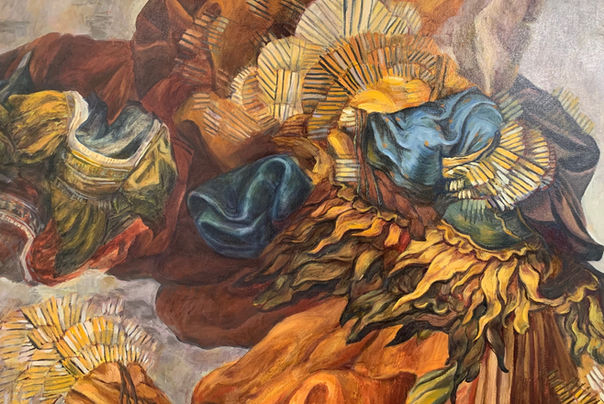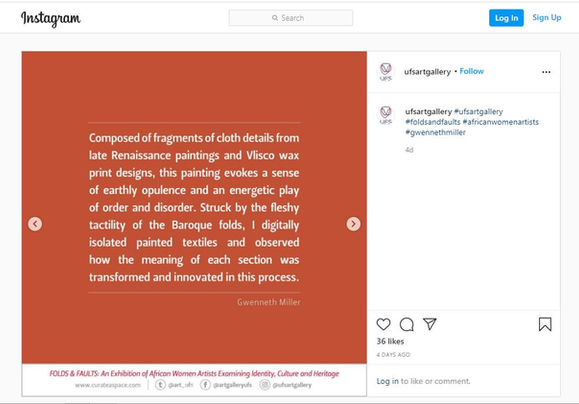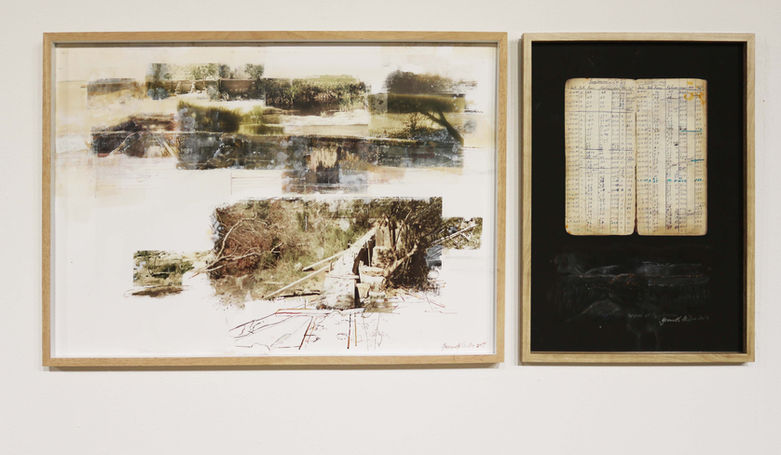top of page
Loss and it's remains 2019
Exhibited at The Unisa Art Gallery 2019
Part of the group exhibition: ART IN PROCESS: an interdisciplinary staff exhibition
Also at Johannes Stegman Art Gallery: Folds and Faults (2020-2021). See Folds and Faults film (2021). Part of the Vrystaat Art Festival (2021)

INSTALLATION VIEW of Loss and it's Remains (2019) in the Unisa Art Gallery
Artist's statement
Loss and its Remains included five artworks. Influenced by personal loss and Kristeva’s [1] writing on despair and sorrow, I evoke the relationship of loss and its tangible fragments. The exhibition included diverse media: oil paintings, collage, mixed media drawing and photographic work, unified under a sub-theme of the fold. The use of layers, relative to specific sites, was a deliberate conceptual and structural device to consider different angles ones can approach the idea of folds. Aligned with the broader theme of affect and complexity, I drew on Deleuze’s [2] writings on the fold and how thought is enfolded within itself.
The Unisa Art Gallery installation was curated to be viewed from left to right, unfolding in three sections:
On the left, occupying a focal position was the large oil painting, Folds: Assumed Abundance, the mid-section comprised of a series on Dams - an oil painting titled Dullstroom Dam and two ink drawings: New dams from the old and Record of Pangbourne; and on the right hand side, four photographs called Speak tenderly to my beloved I-IV.
References
[1] Kristeva, J. 1987. On the melancholic imaginary, in new formations, 3 (Winter): 5-17. Available at http://banmarchive.org.uk/collections/newformations/03_05.pdf
[2] Deleuze, G. 1993. The fold. Leibniz and the Baroque. London: The Athlone Press.
Folds: Assumed Abundance 2017-2018
Oil on canvas. 91.5 x 183 cm. UNISA Art Collection
Unisa Institutional Repository
Artist's statement
Folds. Assumed Abundance was informed by details of fabric as seen in late Renaissance paintings, as well as by patterns from Vlisco wax print designs. Here, the fragments of painted textile draperies are devoid of physical human form, leaving behind just the hollow shapes and traces of the bodies that once filled them. Acknowledging the cut-out, my work positions the contradictions of borrowed material, loss and emptiness, against the assumption of plenitude. Since this work was exhibited at several exhibitions in Johannesburg and Pretoria (see below), each context facilitated shifts in understanding, reframing and additional layers of paint.
This painting affirms my fascination with the spectacle of neo-baroque aesthetics as well as reflecting my intention to remind the viewer of mortality in the face of grandeur. The reflection on humanity that offers conflicting messages, embellished emptiness, or simply less than we expect, is entrenched in history. Like the carnival that allows a riotous atmosphere, this work borrows fragments from unrelated art sources to create this trancelike reconstructed world.
Reference
Eng, D & Kazanjian, D (eds). 2003. Loss The Politics of Mourning. Berkeley Los Angeles London: UNIVERSITY OF CALIFORNIA PRESS
The catalogue of the 2019 ART IN PROCESS: an interdisciplinary staff exhibition, is available at: https://issuu.com/gwenmiller0/docs/2019_unisa_staff_exhibition_catalogue.pptx
The painting was also exhibited at
Rethinking Kakotopia, University of Johannesburg, at Art as Destination: Co-creation of culture, a curated exhibition that ran alongside the 7th Biennial Conference of The International Tourism Studies Association, at the CSIR, Pretoria, and at Sticky TIME, curated Rooftop IX, St Lorient Gallery, Pretoria
The work was also shown at the Recent Acquisitions Exhibition (March 2020, Unisa Art Gallery) as it is now part of the UNISA Art Collection. The painting is accessible for research purposes: for further information contact the curator Bongani Mkhonza at mkhonbw@unisa.ac.za Also see its inclusion in the UNISA Art Gallery's video on the acquisitions https://www.facebook.com/groups/222848047188/permalink/10158868989582189/
Folds: assumed abundance is included in the group exhibition FOLDS AND FAULTS. An Exhibition of African Women Artists Examining Identity, Culture and Heritage, curated by Carol Brown and Zinhle Khumalo, an online Instagram exhibition from September 2020, hosted by University of the Free State (UFS), Bloemfontein.
The Folds and Faults onsite exhibition is on exhibition during August and september 2021, at Johannes Stegmann Art Gallery, University of the Free State (UFS). Curated by Carol Brown, Zinhle Khumalo and Angela de Jesus.
THE DAMS SERIES 2019-2020
New Dams from the old. 2019
Inks on archival paper. 59 x 64 cm
Collection of Ines Potgieter
Unisa Institutional Repository
Record of Pangbourne. 2019
Inks on archival paper. 42 x 59 cm
Unisa Institutional Repository
Dullstroom Dam, 2019-2020
Oil on canvas. 60 x 152 cm. In the permanent collection of the Artbank, South Africa.
UnisaIR link http://hdl.handle.net/10500/27493
Artist's statement
In the Dams series loss was revealed in traces of human exertion and activity. New dams from the old, was collated from photographs I took of ten small dams built by my father to provide water for his animals. Many of the dams were washed away, but in symbolic hope, he would repeatedly repair them.
Record of Pangbourne incorporates a scan of a page from the only record book of his livestock and the cycles of drought and rain
The large oil painting, Dullstroom Dam depicts a drained dam. The repetitive linear patterns of a dark landscape created a sense of an embedded text. Seen this way, the work assumes layered significance - the transcript of loss, and our limited attempts at understanding.
Dullstroom Dam was previously exhibited at To make – a tribute, an exhibition curated by Elfriede Dreyer for the 25th anniversary of the KKNK (from page 37 in the catalogue. My work is on page 52). The exhibition was intended to honour lecturer-artists that have made a consistent contribution to the South African art world over the last few decades.
Speak tenderly to my beloved I-IV. 2019
Inkjet ink on archival paper. Series of 10.
Artist's statement
Speak tenderly to my beloved I-IV reflects the notion of the absent body as represented in the complexities of the fold. In contrast to the above sections, the mood of melancholy has shifted to the affect of bereft (Kristeva). The densities of the folds became a metonym for the absent body. In despair at my impending loss, I recorded my terminally-ill husband’s breathing. An unintended consequence of the video captured close-up views of the folds of his nightgown and its movements. I used this as a starting point for these abstracted images, which reflected the uncanny in the fading life, moving from the physical realm to an unknown world.
In the 2020 context of the current world pandemic, the notion of our frailty is significant.
This installation reflects the tensions and contradictions inherent in complex hope, and the remnants that remind us of ultimate loss. Art critic and historian, Robin Sassen's review of the exhibition (included in the catalogue) described my installation briefly: "These considerably finished paintings, photographs and conceptual reflections are particularly potent and compelling in their physical presence and conceptual resonance."
bottom of page




































